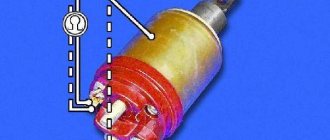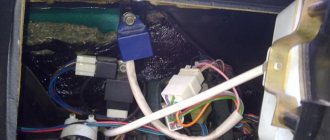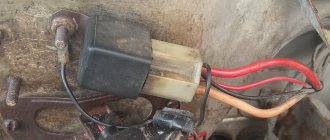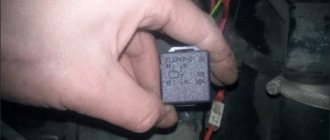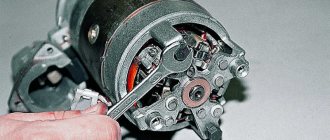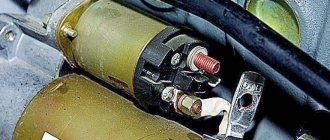Probably all car owners have found themselves in a situation in which the engine does not want to start. Basically, this problem can be solved by charging the battery or cleaning the contact elements. At the same time, sometimes it happens that the problem cannot be solved without repairing the starter solenoid relay. We’ll talk now about how to carry out such a procedure. For those who do not want to figure it out on their own, you can immediately contact a service center where the starter will be repaired efficiently.
Device Features
Before you think about how to disassemble the starter solenoid relay, you need to become familiar with the operating principle of this system. To begin with, it is worth understanding that the device runs on battery power. On the other hand, the device is capable of creating a parallel magnetic field, which affects the armature. The return spring is then compressed, which drives the bendix. At the end it connects to the splines that are on the flywheel.
The principle of operation of the element is based on the subsequent closure of the corresponding contacts. At the same time, due to the action of the magnetic field, the armature of the coil is constantly located inside.
When the engine is started, access to power is limited. At the same time, the spring begins to return to its original position, and the bendix disengages. If you are interested in more detail about the operation of the starter solenoid relay, the video on our page will help you figure it all out.
Video on how to repair the starter retractor relay with your own hands:
How to check the starter retractor relay: video and description
First of all, diagnostic work should begin with checking the starter. To carry out the check, one turn of the key in the ignition is enough. If the device does not work, you will hear characteristic clicks, which confirms that the element is faulty.
Next, you should bridge the contacts, which are represented by two copper bolts located on the relay cover. If the device starts to spin, then most likely the solenoid relay needs to be repaired.
At the same time, another option is also possible. In this case, disconnect the starter. It is important to do everything extremely carefully, because the rotational force of the mechanism is relatively high, so the likelihood of injury is quite high.
After completing the dismantling procedure, we place the part on the ground. Using a wire, we connect the contact terminal with the positive one, as well as the ground of the starter with the ground of the battery. After such operations are completed, you should see the relay start up, which is accompanied by a characteristic clicking sound. If the relay activation is not detected, we begin to inspect the contacts - most likely, they are slightly burnt.
In addition, a breakdown of the system is also indicated by the situation when the relay does not turn off, even if the power unit has already started. You can tell by the buzzing sound coming from the system.
Another symptom is a characteristic click from the ignition system, but the starter never starts working. Finally, a sign will also be the mechanism running idle after the key is turned. At the same time, we see that the engine has not started.
If you don't know how to check the operation of the starter relay, the video on our website will help you figure it out. In it you will find a detailed description of how exactly to carry out a comprehensive diagnosis of this unit.
Video recommendation on how to disassemble the starter solenoid relay:
Is it possible to fix it?
Relays for starters used in Zhiguli cars received identical parts in view of completely identical tasks. The only inconvenience is that, depending on the supplier manufacturer and the modification of the car itself, the attachment points of the units may differ slightly from each other, and some differences in internal components are allowed.
Unit mounting location
There is no point in repairing the devices; for VAZ-2107 and 2106 it is easier to purchase the entire starter assembly. But, if there are financial difficulties, you can only replace the relay. And this is the order in which you should proceed. Be sure to disconnect the battery first! The starter is installed in the car electrical network in such a way that shorting its contacts can lead to burnout of the entire car wiring.
Purchase of VAZ-2106 starter assembly
Then remove and thoroughly clean the starter from dirt. This is necessary to ensure that random particles do not get into the electrical winding and prevent a short circuit. Now we disconnect the contact from the bolt of the traction relay, unscrew the tightening screws and remove the part.
If there is no click when the ignition is turned on, the relay must be replaced. If it is there, but the starter does not work, you need to check the functionality of the contact pairs. To do this, they should be closed with a screwdriver, and the starter should work. Sometimes the cause of the malfunction lies in the lack of electricity to spin the flywheel. To check this, you will need a multimeter; it can be used to measure the voltage at the moment the ignition key is turned.
The test is carried out without removing the starter; changing the relay is not difficult, even a beginner can handle it. After replacement, it is necessary to check the functionality; to do this, simply connect one wire to the contact pair of the relay and the positive terminal of the battery, the second to the negative terminal of the battery and to the starter housing. If the unit is working properly, the gear extends and begins to rotate.
How to repair a relay with your own hands
Basically, repair work involves dismantling a number of mechanisms. Here it is important to remember to take precautions - do not rush, do everything very carefully, turn off the power to the machine. It is also worth considering carefully whether there is a need to repair the starter retractor relay yourself. In the absence of the necessary skills, abilities and tools, you should entrust everything to the hands of professionals - otherwise you can not only aggravate the breakdown, but also get injured.
At the same time, if you decide to carry out repair work yourself, disconnect the power from the battery. This is the initial step to disassemble the starter, otherwise all the car's wiring may burn out.
Dismantling
There should be no problems with the dismantling process. The main thing here is to remove the starter, since the required relay is held on it. Therefore, dismantling is carried out as an assembly.
- Turn on the handbrake, disconnect the battery by removing the negative terminal from it.
- A wire with a large cross-section goes from the battery to the contact of the relay. It can be turned off by unscrewing it using a 13 key.
- Remove the thin winding power wire from the solenoid relay.
- Using the same 13mm wrench, unscrew the three mounting nuts holding the starter to the clutch block.
- You can remove the device through the bottom or top. If you chose the top, then you need to slightly rotate the starter around its axis and remove it.
- The lower output is more difficult, since here you need to remove the crankcase protection. But if parallel work is carried out that requires similar manipulations, problems will not arise.
What's the end result?
So, as you can see, replacing a faulty solenoid relay is not that difficult . On the other hand, everything must be done very carefully and thoroughly, otherwise there is a high probability of damaging the engine starting system, or getting seriously injured.
Thus, if you are worried about whether you can carry out repairs yourself, it is better to seek help from professionals - they will help you quickly restore the functionality of this unit.
Video review of repairing the starter solenoid relay yourself:
A faulty starter relay is often the reason why the car refuses to start when the key is turned in the ignition. Perhaps these are not the most pleasant moments in the life of any driver. Therefore, in such cases, it is important to know how to check the starter solenoid relay, and how to start the car if it does not work.
We will tell you about the purpose of the starter solenoid relay and its structure, how you can check it and perform simple repairs yourself.
At the end of this article, watch the video that shows how to start your car if the starter solenoid relay is not working.
Also on our website you can find information about other common causes of starter malfunction with step-by-step instructions on what to do if the starter does not work.
When, when you turn the key in the ignition switch, you can clearly hear that the starter is idling, then the cause of this malfunction may be the solenoid relay. But before you start diagnosing it, you should know the purpose of this electrical unit.
Causes of malfunctions when the element does not work
Malfunctions of the starter retractor relay cause immobilization of the vehicle. They may be due to:
- reducing the contact area of platinum contacts;
- winding breakage or burnout;
- deformation of the return type spring;
- short circuit in one of the windings.
Purpose of the starter retractor relay
As you know, a starter is an electric motor that is powered by a battery. When starting the engine, the starter gear must quickly engage with the flywheel ring of the engine crankshaft. At the same time, the starter electric motor is turned on, which rotates the crankshaft - this process in action is clearly visible in the animation below.
The starter solenoid relay is responsible for quickly connecting two toothed parts: the flywheel and the overrunning clutch gear (Bendix). The retractor relay is installed on the starter housing, connecting to the clutch in the front using a lever. If the relay does not push the gear forward, then the starter rotates on its own.
However, the culprit of such a malfunction may be not only the retractor relay, but also the overrunning clutch (read more about Bendix repair). If the clutch is jammed, then the force of the retractor relay is not enough to extend it.
Checking status
Before changing the relay, make sure that the problem with starting the engine is related to this component.
To do this, consider two situations that indicate its malfunction.
| Situation | Your actions |
| The relay makes clicks, but the armature does not spin | If there are clicks from the relay, check the condition of the armature. To do this, the terminals of the retractor relay are bridged with a large screwdriver or a piece of welding cable to the terminals at the ends. Taking a thin wire or a screwdriver can easily burn the terminals. When the armature is working, after closing the terminals, the armature will spin, which can be determined by the sound. Consequently, the solenoid relay itself has failed and requires repair. |
| The relay is completely silent | Even if there is silence after closing the terminals, the problem should be looked for in the starter. The relay no longer plays any role here. |
Having discovered that the relay has served its purpose, it must be replaced or repaired, if possible.
Checking the starter retractor relay
To determine the reason for the lack of connection between the gear elements of the starter and the engine, you should check the functionality of the solenoid relay. For ease of diagnosis, most often it is necessary to dismantle the entire starter.
However, before you begin dismantling the starter, it is advisable to carry out several simple operations that will help identify the problem:
- Check the condition of the battery, the reliability of the terminals, remove oxides from the battery terminals;
- Make sure that the electrical wiring is securely attached to the starter with nuts. If there is corrosion, clean the contacts with fine-grained sandpaper;
- Find the starter switch relay in the car and check its condition.
Starter removal procedure
To remove the starter, you need to disconnect the wires that go to it, and then unscrew the mounting bolts (usually two or three).
Repair of starter retractor relay
First, we suggest watching a video instruction on how to replace the solenoid relay yourself, and then we will tell you how to repair it.
Depending on the manufacturer, starters are equipped with a collapsible or non-demountable solenoid relay. To fix a problem with a non-separable element, you just need to buy a new part. All that remains is to unscrew the two mounting bolts, remove the faulty relay and install a new one in its place (see the video above).
In the case of a detachable solenoid relay, you can try to repair it. The repair is as follows:
- Unscrew the screws securing the housing cover.
- Sometimes it is necessary to additionally solder the ends of the winding.
- Removing the cover opens up access to find a possible problem - these are power contacts that may be worn out or burnt:
- in the first case, replacing contacts will help,
- in the second case, the problem can be solved with the help of sanding paper.
- Now all that remains is to assemble the solenoid relay and check its functionality.
- The repaired starter is installed in place, after which its operation can be tested.
And lastly, we recommend watching a video that shows how you can start a motor with a non-working starter solenoid relay.
Diagnostics without removing the starter using a multimeter
To do this, use a multimeter (tester) to first sequentially measure the voltage at the terminals of the battery, disconnected from the vehicle’s on-board network. It is approximately 12.7 V. If the device readings are less than 12 V, the battery is considered to be severely discharged and is not suitable for further testing.
Next, restore the normal connection of the wires and measure the voltage at the battery terminals and relay contacts. Compared to the previous case, it changes by no more than 0.1 V and will be equal at both control points. Turn the key to the start position. The voltage at the relay contacts should not fall below 12 V. Otherwise, the connecting wires are most likely faulty; it is possible that one or more contacts in the current flow circuit have burnt out.
Cleaning contacts and replacing individual parts
After removing the cover, you can assess the condition of the contact plates. Carbon deposits or oxidation should be removed using sandpaper. You can try to replace damaged springs, if any, by selecting ones that are suitable in size and characteristics. Selecting springs is a very complicated matter. It is necessary to measure not only the dimensions, but also the force developed. It will not be possible to do this without having special equipment at your disposal.
Having completed the repair, we place the cover in place, lubricate the joint with sealant, secure it and recheck it. After making sure that all parameters are normal, we install the relay on the starter and perform final assembly.
To be honest, such repairs will not last long. Over time, the plates fade, become thinner and are no longer able to provide reliable contact. We note once again that it is advisable to carry out such work only in situations where there is no access to spare parts. In other cases, the correct solution is to replace the starter solenoid relay with a new and known good part.
How to start a car if the starter solenoid relay does not work
Starter and retractor relay VAZ 2110
If the car suddenly stops starting, there are no characteristic sounds before starting the engine, or a strange “humming” noise appears, then the starter solenoid relay may be damaged. Naturally, the device can sometimes work normally without showing signs of breakdown, but at the most inopportune moments the car has to be started from the pusher. In this situation, only replacing the retractor on the VAZ 2110 starter will change everything for the better. Symptoms of the malfunction are different, for example, the appearance of clicks at the relay, lack of cranking of the starter, lack of signs of life when turning the ignition key, etc. It is worth noting that replacing the VAZ 2110 retractor starter can be done with your own hands.
Signs of a malfunctioning retractor
The following signs may indicate a retractor failure:
- After starting the engine, the starter does not turn off; it rotates at high speed and has a characteristic buzzing sound.
- After turning the key in the ignition switch, a click occurs, indicating that the device is activated, but no rotation of the starter is observed. Sometimes, if there is a break in the coil, the armature is stuck in a certain position, or there is no power, there may be no click.
- After turning the key in the lock, the starter begins to idle without affecting the engine flywheel.
Solenoid relay
The VAZ 2110 starter solenoid relay is designed to remotely turn on the electric starter motor. They ensure the clutch of the bendix (see Replacing the bendix on the VAZ 2110 starter on your own) with the flywheel crown. This element structurally consists of: a returning, contact and magnetic system, including two coils - a holding coil, connected to the control terminal and going to the housing, and a retracting coil, connected by the control element.
VAZ 2110 starter solenoid relay
The pipe where the armature is located is a core, inside of which there is a copper winding (the end and beginning of the winding are attached with terminals, one side is connected to the electric motor and the control contact, the other is connected to the control terminal and goes to the housing).
VAZ 2110 retractor clicks and the starter does not turn
The movement of the armature in the core is carried out due to the electromagnetic field, and when the voltage disappears, the armature in the core goes to its initial state. When powered, a magnetic field appears, causing the armature to retract the return springs. When the car engine starts, the voltage begins to disappear, the spring presses on the armature and it returns to its initial position, the contacts open, the Bendix disengages. If the solenoid relay breaks down and before replacing it, you should first make sure that the problem lies in the starter.
Note. It is necessary to exclude the following malfunctions in the car: the presence of scale, battery discharge, traces of oxidation on the terminals, damage to the wiring, loose contacts. The car may not start for these reasons.
Signs and causes of relay failure
If the relay is broken, the following signs will tell you about it:
- when you try to start the engine with the key, it does not start, or starts only after two or three attempts;
- There is a buzzing sound after the engine starts. This means that the starter rotates at higher speeds, although it should no longer be.
If at least one of these signs is observed, then this is a reason to be wary. The relay may soon break. There are several reasons why this happens:
- one of the windings, or both, were burned or broken at once;
- deformation of the return spring inside the mechanism;
- a short circuit has occurred inside the part on one of the windings;
- The surface area of the contact plates has decreased, or they have completely burned out.
Understanding the reasons why the relay fails, repairs will take less time, because It’s immediately clear where to look for the problem.
We recommend: Wheel balancing. Why is this so important?
